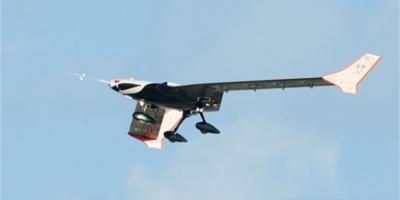Thu, Apr 17, 2014
Test Flights With A Flexible Wing To Be Conducted This Summer
The latest in a long series of experimental research aircraft, or X-planes, recently arrived at NASA's Armstrong Flight Research Center. Lockheed Martin, developer of the X-56A Multi-Utility Technology Testbed, is currently using the aircraft to explore technologies for active flutter suppression and gust load alleviation for the Air Force Research Laboratory's Multi-utility Aeroelastic Demonstration program.

The remotely piloted airplane had been housed at Edwards Air Force Base's North Base complex since last spring, where it was flown in a series of baseline tests involving a standard stiff wing. Pending resolution of scheduling and technical issues, the modular X-56A will be flown this summer with a flexible wing. Once these tests are concluded, the airplane and its ground control station will be transferred to NASA for follow-on research involving enabling technologies for new kinds of lightweight, energy-efficient, flexible aircraft.
According to NASA, the modular X-56A system includes two center bodies, a set of stiff wings, three sets of flexible wings, a ground control station, and a transportation trailer. The X-56A has easily removed wings and is convertible to other wing configurations, such as a joined-wing planform or a wing-tail configuration. The aircraft is equipped with a ballistic parachute recovery system, which is intended to recover the fuselage and the majority of the aircraft systems in the event of an inflight wing failure.

The initial flight tests of the X-56A system, performed by Lockheed and AFRL in the latter half of 2013 and extending into early 2014, collected flight data on highly flexible structures and flutter suppression control technology. Initially flown with a conventional stiff wing, the aircraft is subsequently being used to evaluate active flutter suppression with the flexible wings in early 2014. After these flights are completed, the X-56A will be transferred to NASA Armstrong to be used for research into lightweight structures and advanced control technologies for future efficient, environmentally friendly transport aircraft.
(Images provided by NASA)
More News
From 2023 (YouTube Version): Legacy of a Titan Robert (Bob) Anderson Hoover was a fighter pilot, test pilot, flight instructor, and air show superstar. More so, Bob Hoover was an i>[...]
Get The Latest in Aviation News NOW on Instagram Are you on Instagram yet? It's been around for a few years, quietly picking up traction mostly thanks to everybody's new obsession >[...]
Aero Linx: B-52H Stratofortress The B-52H Stratofortress is a long-range, heavy bomber that can perform a variety of missions. The bomber is capable of flying at high subsonic spee>[...]
Altimeter Setting The barometric pressure reading used to adjust a pressure altimeter for variations in existing atmospheric pressure or to the standard altimeter setting (29.92).>[...]
"Knowing that we play an active part in bettering people's lives is extremely rewarding. My team and I are very thankful for the opportunity to be here and to help in any way we ca>[...]
 Classic Aero-TV: Remembering Bob Hoover
Classic Aero-TV: Remembering Bob Hoover ANN FAQ: Follow Us On Instagram!
ANN FAQ: Follow Us On Instagram! ANN's Daily Aero-Linx (05.15.24)
ANN's Daily Aero-Linx (05.15.24) ANN's Daily Aero-Term (05.15.24):Altimeter Setting
ANN's Daily Aero-Term (05.15.24):Altimeter Setting Aero-News: Quote of the Day (05.16.24)
Aero-News: Quote of the Day (05.16.24)




